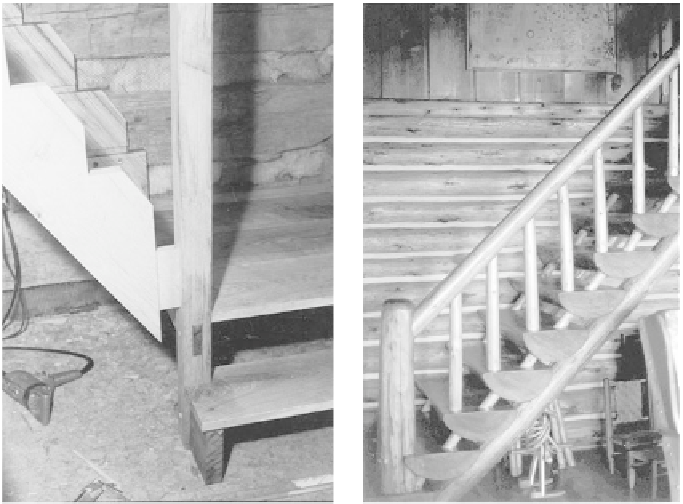Civil Engineering Reference
In-Depth Information
which were close, sometimes five feet away. Of course
there was no window in that half wall, and the treads
were maybe only five inches deep. Like it or not, you
went upstairs on tiptoes.
Circular stairs, around a central pole, are popular
just now because they take up little room and meet
most building codes. They can be bought for as little
as $400 on up. Often you must cut and head off ceil-
ing joists to accommodate these (and any other) stairs,
so you'll want to plan ahead. Also keep in mind that
it's very difficult to move large objects up or down tight
spiral stairs.
Here I'll note that code requirements apply to liv-
ing spaces and not to storage. You can use a ladder to
get up to a storage loft and be legal, as long as you're
not storing warm bodies up there. And, of course, after
final inspection and approval, and issuance of an
occupancy permit, people will do more to their houses.
Sometimes we can reuse a complete staircase, or
parts of one. It is essential that each riser be the same
height and each tread the same depth for safety. So if
you cut down a staircase for reuse, you may have to
modify the whole thing.
Floors and stairs are where we use really good-
looking wood. The Virginia favorite is remilled, oiled
heart pine. Stairs, along with their railings, and inte-
rior trim and cabinetry are showcases for fine work-
manship. Take a lot of time, and a lot of pride in them.
Floors and Stairs
Checklist
Choose plywood or tongue-in-groove
for the subfloor.
Look for remilled flooring from
specialty suppliers.
Finish wood floors according to your
preference.
Consider whether the floor for the
upstairs will be the ceiling downstairs.
Seal a concrete slab floor to prevent
moisture intrusion.
Lay flagstone on a concrete slab or
embed stones in sand.
Check building codes before
planning stairs.
Choose a form of stair construction.
Consider mortising each stair tread
into the stringer.
Remember that railing height is
32 inches and spindles are
maximum four inches apart.
LEFT
Stringer mortised to vertical post. Treads
were also mortised into stringers for this oak
stairway. My brother Dan was the carpenter.
RIGHT
Rustic stair treads of half-logs in Gordon
and Jane Dolton's Michigan cabin, built by her
parents in the 1930s.







